|
Crew: 1
Number built: 1,767 with the RAF initially ordering 675 (475 + 200 from France) but only
accepting about 80
Dimensions
Wingspan: 34 ft.
Length: 30 ft. 2 in.
Height: 12 ft. 5 in.
Wing area: 213 sq ft.
Armament
Guns: Originally 4 X 8 mm MGs - RAF replaced with 0.30 in. MGs, Originally 2 X 12.7
mm MGs - RAF
replaced with 0.50 in. MGs, Originally 1 X 37mm cannon - RAF replaced with 20 mm
Hispano Suiza
cannon.
Bomb load: 1 X 500 lb.
Performance
Engine: 1 X 1,150 hp Allison V-1710-35
Maximum speed: 360 mph
ROC: 2,400 ft/min
Maximum ceiling: 32,100 ft.
Range: 600 mi., extended range with drop tank 1,100 mi.
Weight
Empty: 5,462 lbs
Loaded: 7500 lbs
Maximum: 8,200 lbs
Hobby Master 1/72 Air Power Series
HA1704
Bell P-400, 347th FG, 67th FS,
13th USAAF, Guadalcanal, 1942
|
THESE ARE PRE-PRODUCTION
PICTURES NOT THE FINAL PRODUCT
|
Die-cast metal.
Pre-painted with pad applied markings.
Fully assembled.
Weapons that are not permanently attached.
Comes with a pilot figure.
Display stand included.
Option to display model with wheels up or down.
Movable propeller.
Minimum use of plastic.
Very collectable.
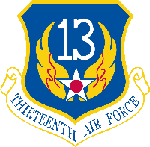 Mk. I. The original order was for 475 aircraft under the Lend-Lease Act and they would
also take over the 200 aircraft France had ordered before it fell to the Germans.
Because of the planes inability to climb to high altitudes and its relatively short range it
was deemed inadequate. As a result only 80 of the planes were actually accepted by the
RAF 601 Squadron.
The Soviets were in need of aircraft and gladly accepted some of the planes the British
had rejected. The aircraft performed remarkably well because it was put into a role of
ground attack, the role that best suited this plane’s characteristics and attributes. The
USAAF took possession of the remaining 179 aircraft and re-designated them P-400.
The 67th started out as the 67th Pursuit Squadron in 1941. They were sent to Australia
in January 1942 and on May 15 they became the 67th Fighter Squadron. Their first task
was providing air defense of New Caledonia. Because of the aircraft design and
limitations the P-400 couldn’t compete with the nimble Zero and without oxygen
capabilities they couldn’t even climb high enough to pursue the Japanese bombers.
Eventually they were re-tasked with ground attack and strafing. This proved to be what
they were best at as was demonstrated on September 14, 1942.
While the Marines had captured Guadalcanal and an enemy airstrip renamed Henderson
Field, the Japanese intended to retake the island and mounted a large force including
naval vessels to shell the Americans. The Japanese had landed several thousand troops
on Guadalcanal and the Marines had battled with them for several days. Without
reinforcements and supplies running extremely low the Marines were forced back to
within 1700 yards of the airfield. They took their stand along a ridge known by many
names, Edson’s Ridge, Marine Ridge, Lunga Ridge, Raider Ridge and probably the best-
known Bloody Ridge. Because of the shape of the ridge when viewed from the air the
Japanese referred to it as “The Centipede”. If the Japanese broke through here it meant
the island would fall.
We all know how heroic the US Marines were on Guadalcanal and at Bloody Ridge but
there is a part of that day that the history books seem to give little credit.
Knowing the Japanese were getting ready to mount an all out final assault at Henderson
Field the US Marines called upon the USAAF 67th FS for assistance. The 67th FS P-
400s had taken terrific damage from enemy air attacks and while conducting during their
own assaults. This meant the 67th was down to three aircraft for the job.
At first light on September 14, 1942 the three P-400s took flight knowing their Marines
were on the ridge and the Japanese were gathering in the jungle just below. Because of
the ridge on one side and the jungle on the other there was only one flight path, down
through the middle. The three planes spaced themselves out enough to allow for single
file passes. The first aircraft dove in with its two 30 cal and two 50 cal machine guns and
one 20mm cannon spewing bullets into the surprised Japanese troops that were caught
in a clearing just starting their attack. Before the enemy knew what had happened the
aircraft had pulled up and out of rifle range.
The second plane wasn’t so lucky because the Japanese were prepared. As the plane
started to dive for the attack rifle fire hit the aircraft’s radiator making it necessary for the
pilot to pull up and make a dead stick landing at Henderson Field.
The third P-400 started his run and made a successful pass without taking a hit. The first
aircraft lined up for his second strafing run and ripped through the Japanese troops but
on his climb out he too was hit in the radiator and was forced to land. Plane number
three started his second pass and although taking several hits none seemed to do any
damage so he circled one more time. His third run was as deadly on the Japanese
soldiers but with several more hits on the plane it began to smoke and he too was forced
to land.
By this time the enemy was in such disarray and confusion that they began to retreat.
Between the Marines and the 3 P-400s from the 67th FS more than 600 Japanese
soldiers fell victim on that day at Bloody Ridge.
It is because of their bravery and actions that the lead pilot, Capt John A. Thompson
received the Navy Cross and each of his two wingmen Lt. B. W Brown and Lt. B. E.
Davis were presented with Silver Stars.
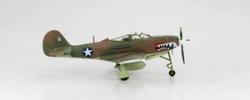 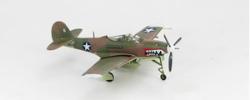 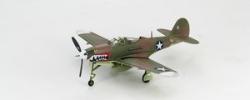 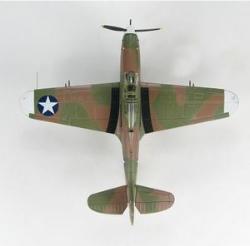 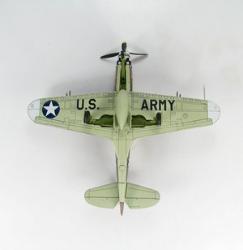 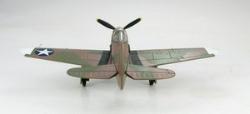 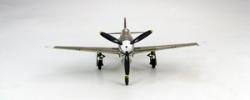 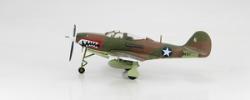 |

